Page 263 of 440
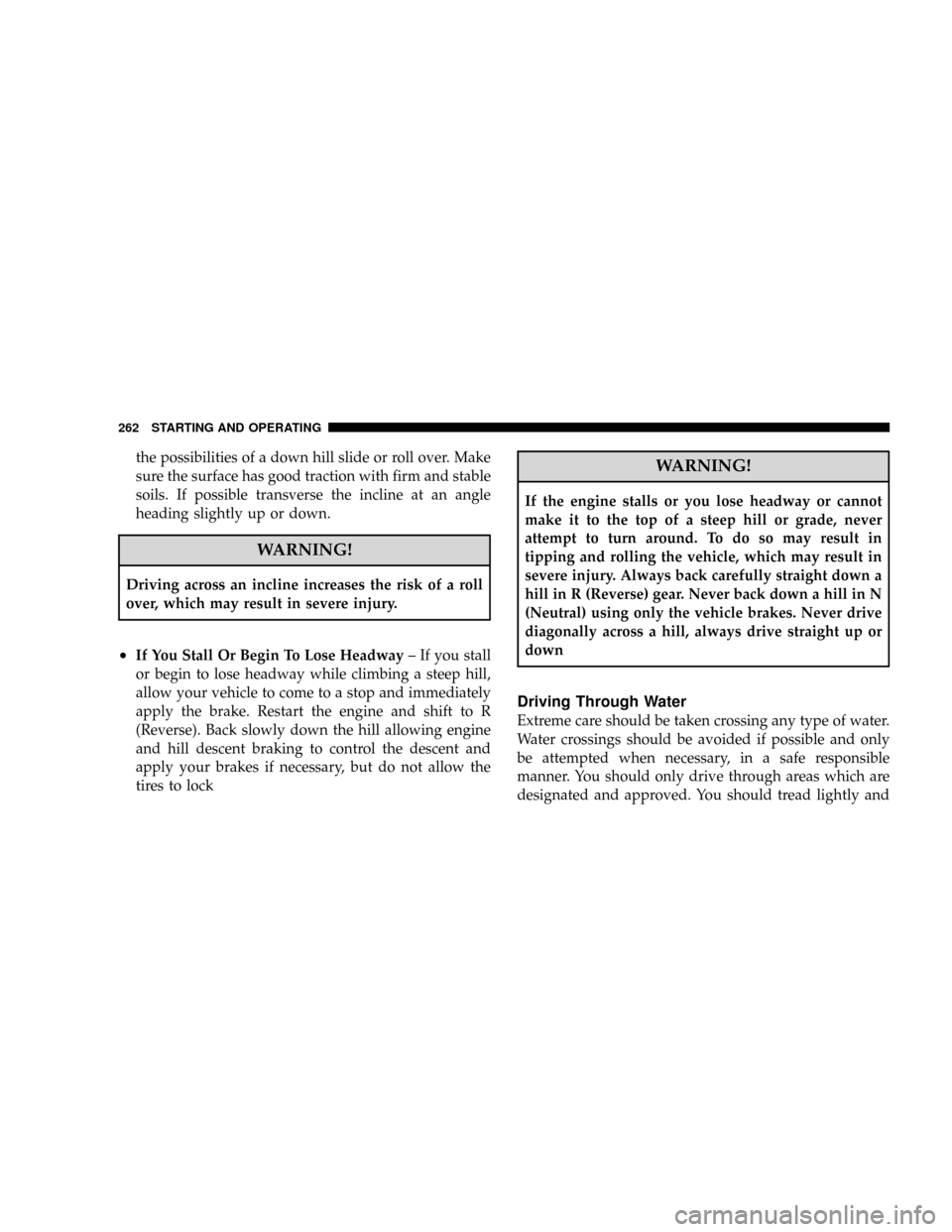
the possibilities of a down hill slide or roll over. Make
sure the surface has good traction with firm and stable
soils. If possible transverse the incline at an angle
heading slightly up or down.
WARNING!
Driving across an incline increases the risk of a roll
over, which may result in severe injury.
²If You Stall Or Begin To Lose Headway± If you stall
or begin to lose headway while climbing a steep hill,
allow your vehicle to come to a stop and immediately
apply the brake. Restart the engine and shift to R
(Reverse). Back slowly down the hill allowing engine
and hill descent braking to control the descent and
apply your brakes if necessary, but do not allow the
tires to lock
WARNING!
If the engine stalls or you lose headway or cannot
make it to the top of a steep hill or grade, never
attempt to turn around. To do so may result in
tipping and rolling the vehicle, which may result in
severe injury. Always back carefully straight down a
hill in R (Reverse) gear. Never back down a hill in N
(Neutral) using only the vehicle brakes. Never drive
diagonally across a hill, always drive straight up or
down
Driving Through Water
Extreme care should be taken crossing any type of water.
Water crossings should be avoided if possible and only
be attempted when necessary, in a safe responsible
manner. You should only drive through areas which are
designated and approved. You should tread lightly and
262 STARTING AND OPERATING
Page 266 of 440
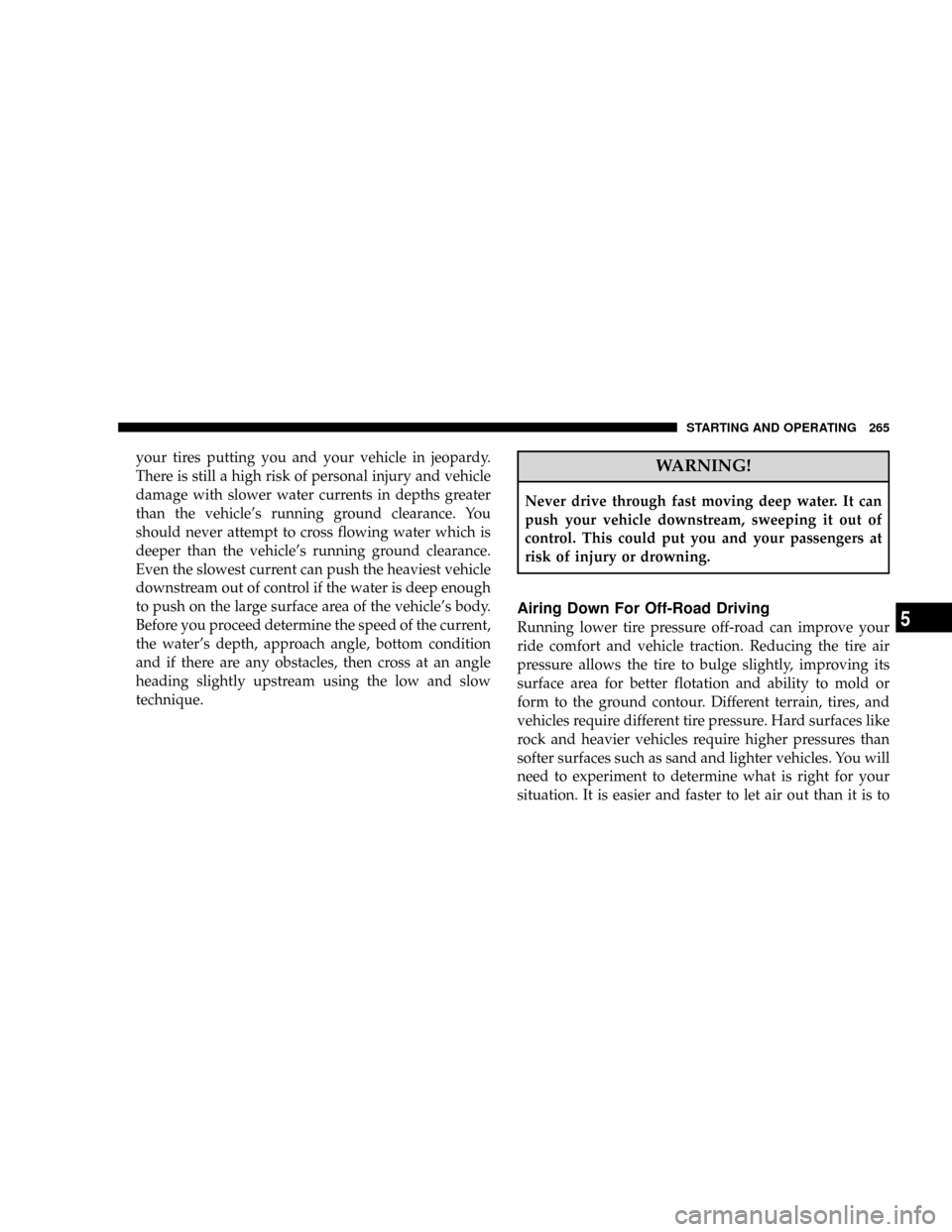
your tires putting you and your vehicle in jeopardy.
There is still a high risk of personal injury and vehicle
damage with slower water currents in depths greater
than the vehicle's running ground clearance. You
should never attempt to cross flowing water which is
deeper than the vehicle's running ground clearance.
Even the slowest current can push the heaviest vehicle
downstream out of control if the water is deep enough
to push on the large surface area of the vehicle's body.
Before you proceed determine the speed of the current,
the water's depth, approach angle, bottom condition
and if there are any obstacles, then cross at an angle
heading slightly upstream using the low and slow
technique.WARNING!
Never drive through fast moving deep water. It can
push your vehicle downstream, sweeping it out of
control. This could put you and your passengers at
risk of injury or drowning.
Airing Down For Off-Road Driving
Running lower tire pressure off-road can improve your
ride comfort and vehicle traction. Reducing the tire air
pressure allows the tire to bulge slightly, improving its
surface area for better flotation and ability to mold or
form to the ground contour. Different terrain, tires, and
vehicles require different tire pressure. Hard surfaces like
rock and heavier vehicles require higher pressures than
softer surfaces such as sand and lighter vehicles. You will
need to experiment to determine what is right for your
situation. It is easier and faster to let air out than it is to
STARTING AND OPERATING 265
5
Page 335 of 440
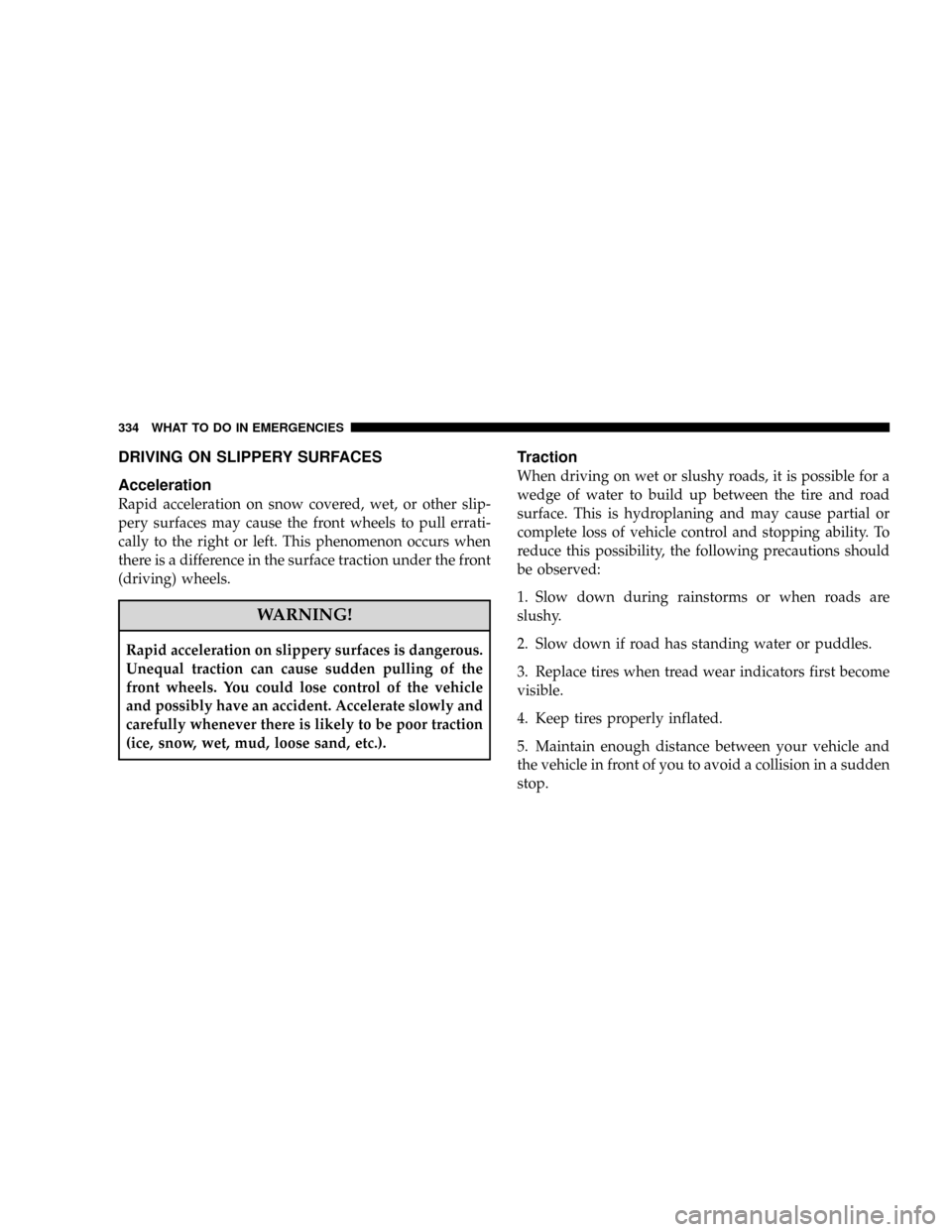
DRIVING ON SLIPPERY SURFACES
Acceleration
Rapid acceleration on snow covered, wet, or other slip-
pery surfaces may cause the front wheels to pull errati-
cally to the right or left. This phenomenon occurs when
there is a difference in the surface traction under the front
(driving) wheels.
WARNING!
Rapid acceleration on slippery surfaces is dangerous.
Unequal traction can cause sudden pulling of the
front wheels. You could lose control of the vehicle
and possibly have an accident. Accelerate slowly and
carefully whenever there is likely to be poor traction
(ice, snow, wet, mud, loose sand, etc.).
Traction
When driving on wet or slushy roads, it is possible for a
wedge of water to build up between the tire and road
surface. This is hydroplaning and may cause partial or
complete loss of vehicle control and stopping ability. To
reduce this possibility, the following precautions should
be observed:
1. Slow down during rainstorms or when roads are
slushy.
2. Slow down if road has standing water or puddles.
3. Replace tires when tread wear indicators first become
visible.
4. Keep tires properly inflated.
5. Maintain enough distance between your vehicle and
the vehicle in front of you to avoid a collision in a sudden
stop.
334 WHAT TO DO IN EMERGENCIES
Page 419 of 440
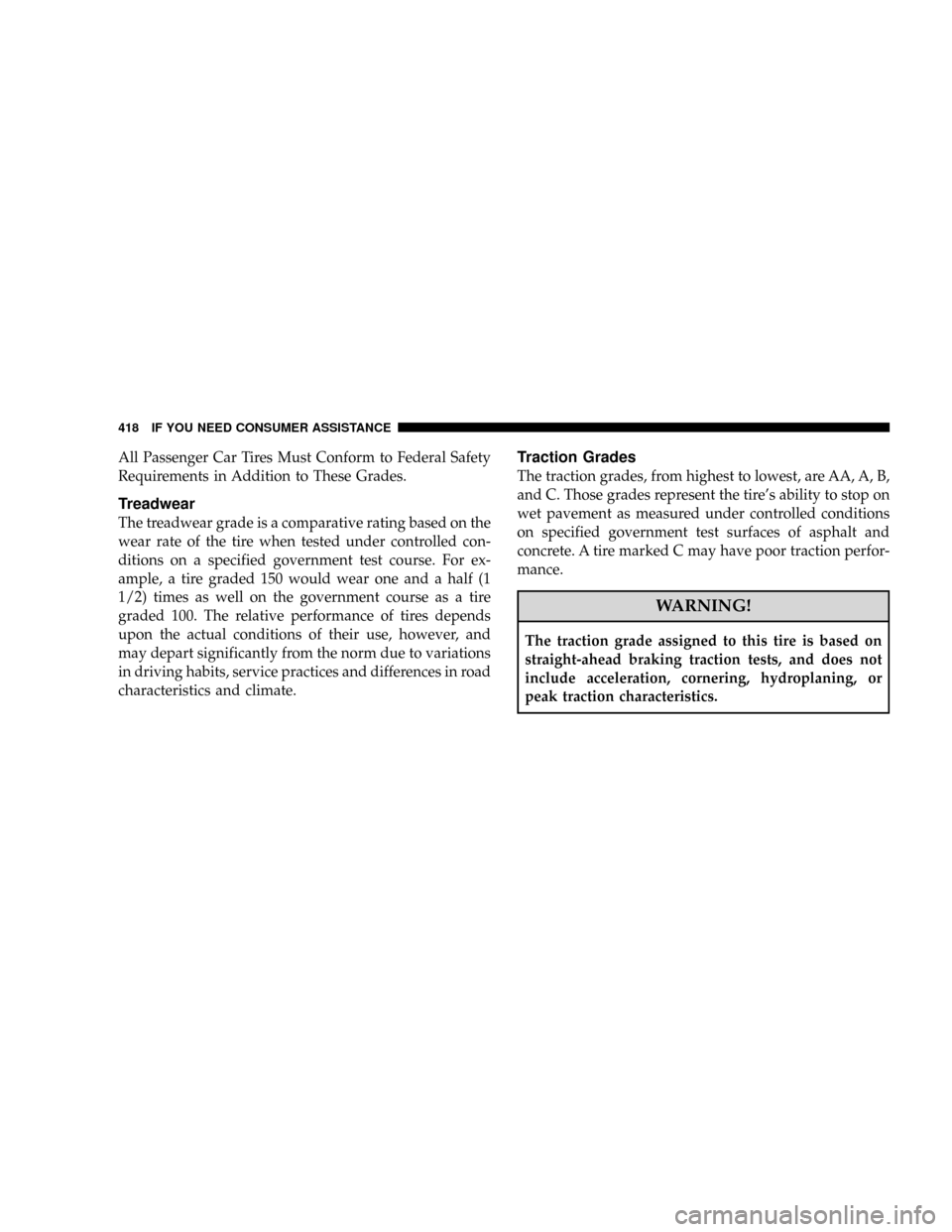
All Passenger Car Tires Must Conform to Federal Safety
Requirements in Addition to These Grades.
Treadwear
The treadwear grade is a comparative rating based on the
wear rate of the tire when tested under controlled con-
ditions on a specified government test course. For ex-
ample, a tire graded 150 would wear one and a half (1
1/2) times as well on the government course as a tire
graded 100. The relative performance of tires depends
upon the actual conditions of their use, however, and
may depart significantly from the norm due to variations
in driving habits, service practices and differences in road
characteristics and climate.
Traction Grades
The traction grades, from highest to lowest, are AA, A, B,
and C. Those grades represent the tire's ability to stop on
wet pavement as measured under controlled conditions
on specified government test surfaces of asphalt and
concrete. A tire marked C may have poor traction perfor-
mance.
WARNING!
The traction grade assigned to this tire is based on
straight-ahead braking traction tests, and does not
include acceleration, cornering, hydroplaning, or
peak traction characteristics.
418 IF YOU NEED CONSUMER ASSISTANCE
Page 426 of 440
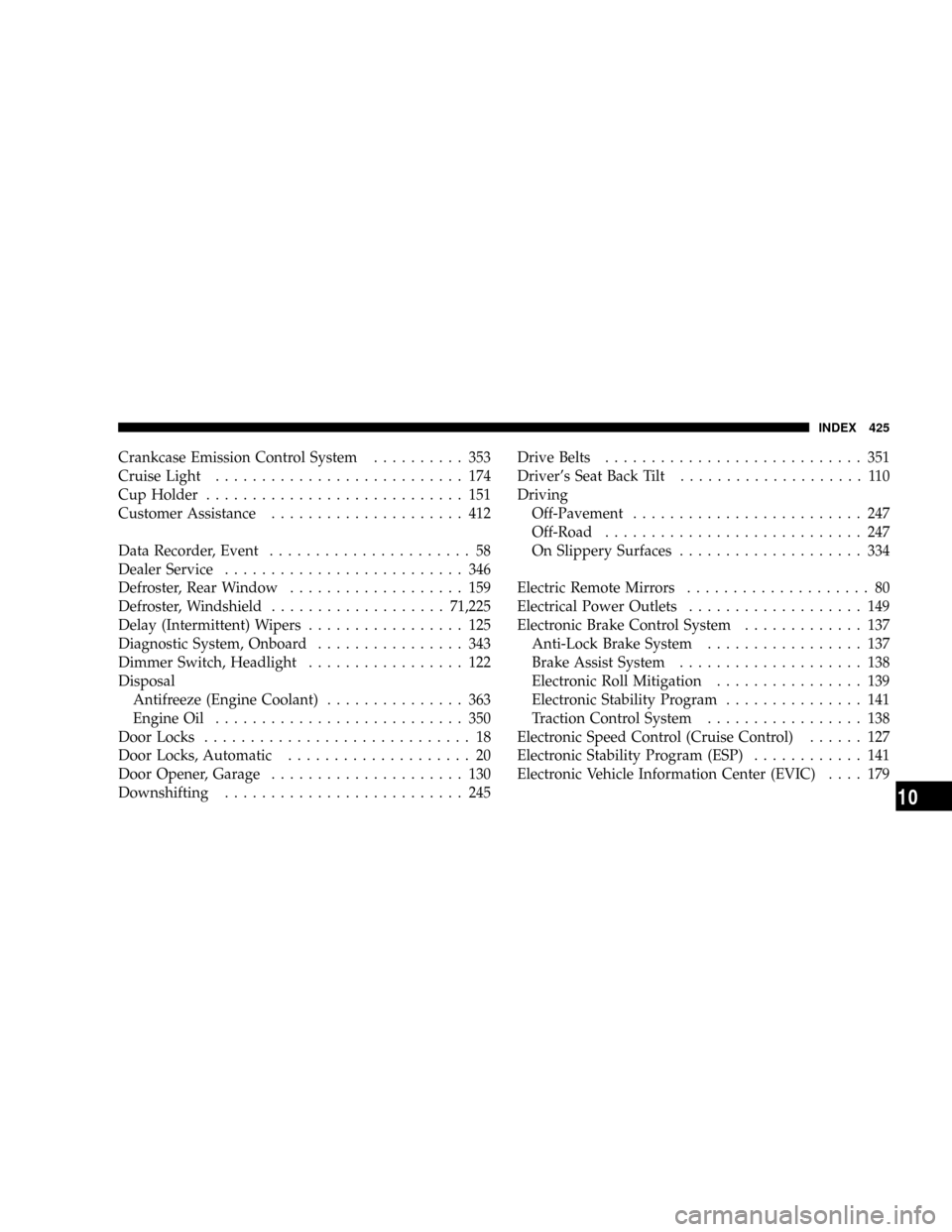
Crankcase Emission Control System.......... 353
Cruise Light........................... 174
Cup Holder............................ 151
Customer Assistance..................... 412
Data Recorder, Event...................... 58
Dealer Service.......................... 346
Defroster, Rear Window................... 159
Defroster, Windshield...................71,225
Delay (Intermittent) Wipers................. 125
Diagnostic System, Onboard................ 343
Dimmer Switch, Headlight................. 122
Disposal
Antifreeze (Engine Coolant)............... 363
Engine Oil........................... 350
Door Locks............................. 18
Door Locks, Automatic.................... 20
Door Opener, Garage..................... 130
Downshifting.......................... 245Drive Belts............................ 351
Driver's Seat Back Tilt.................... 110
Driving
Off-Pavement......................... 247
Off-Road............................ 247
On Slippery Surfaces.................... 334
Electric Remote Mirrors.................... 80
Electrical Power Outlets................... 149
Electronic Brake Control System............. 137
Anti-Lock Brake System................. 137
Brake Assist System.................... 138
Electronic Roll Mitigation................ 139
Electronic Stability Program............... 141
Traction Control System................. 138
Electronic Speed Control (Cruise Control)...... 127
Electronic Stability Program (ESP)............ 141
Electronic Vehicle Information Center (EVIC).... 179
INDEX 425
10
Page 431 of 440
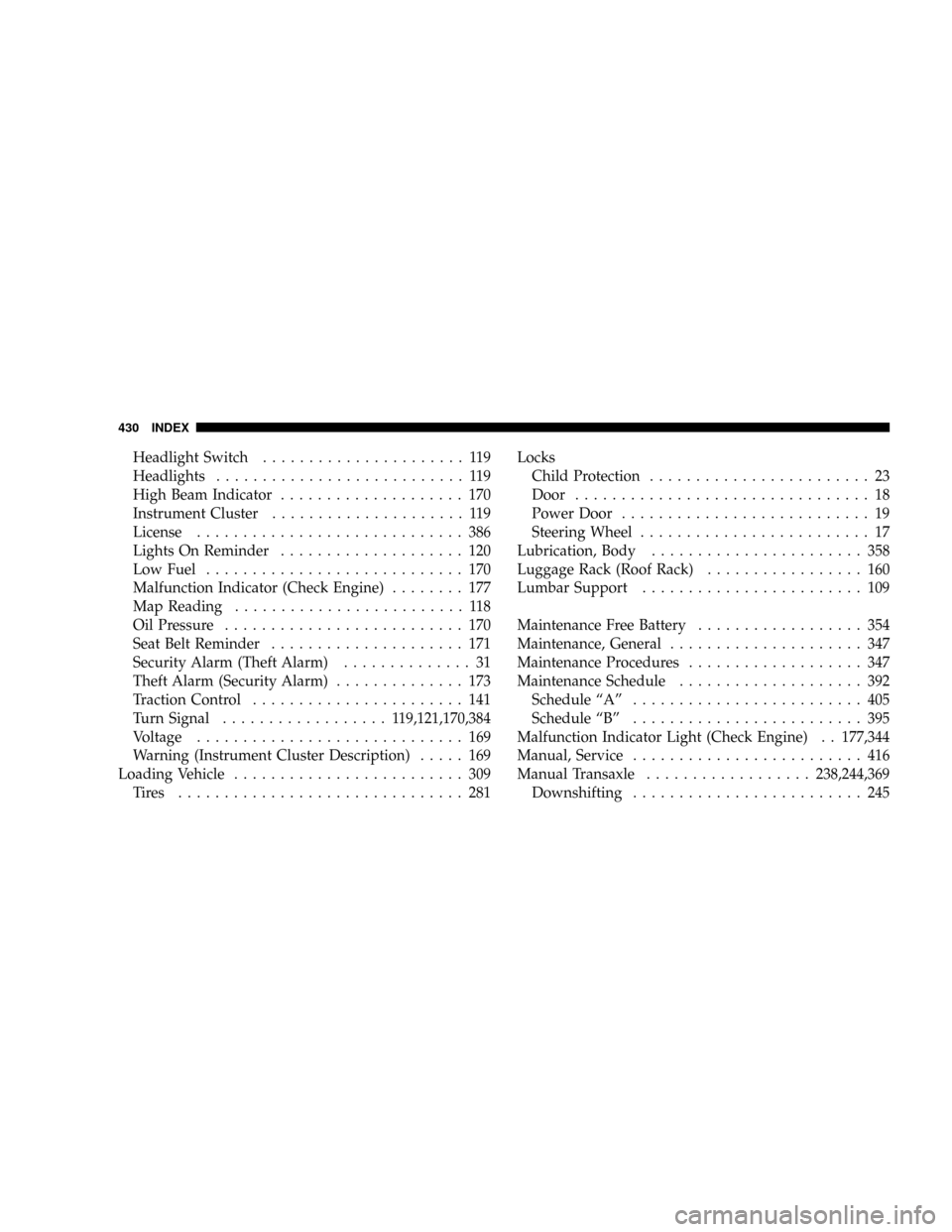
Headlight Switch...................... 119
Headlights........................... 119
High Beam Indicator.................... 170
Instrument Cluster..................... 119
License............................. 386
Lights On Reminder.................... 120
Low Fuel............................ 170
Malfunction Indicator (Check Engine)........ 177
Map Reading......................... 118
Oil Pressure.......................... 170
Seat Belt Reminder..................... 171
Security Alarm (Theft Alarm).............. 31
Theft Alarm (Security Alarm).............. 173
Traction Control....................... 141
Turn Signal.................. 119,121,170,384
Voltage............................. 169
Warning (Instrument Cluster Description)..... 169
Loading Vehicle......................... 309
Tires ............................... 281Locks
Child Protection........................ 23
Door................................ 18
Power Door........................... 19
Steering Wheel......................... 17
Lubrication, Body....................... 358
Luggage Rack (Roof Rack)................. 160
Lumbar Support........................ 109
Maintenance Free Battery.................. 354
Maintenance, General..................... 347
Maintenance Procedures................... 347
Maintenance Schedule.................... 392
Schedule ªAº......................... 405
Schedule ªBº......................... 395
Malfunction Indicator Light (Check Engine) . . 177,344
Manual, Service......................... 416
Manual Transaxle..................238,244,369
Downshifting......................... 245
430 INDEX
Page:
< prev 1-8 9-16 17-24